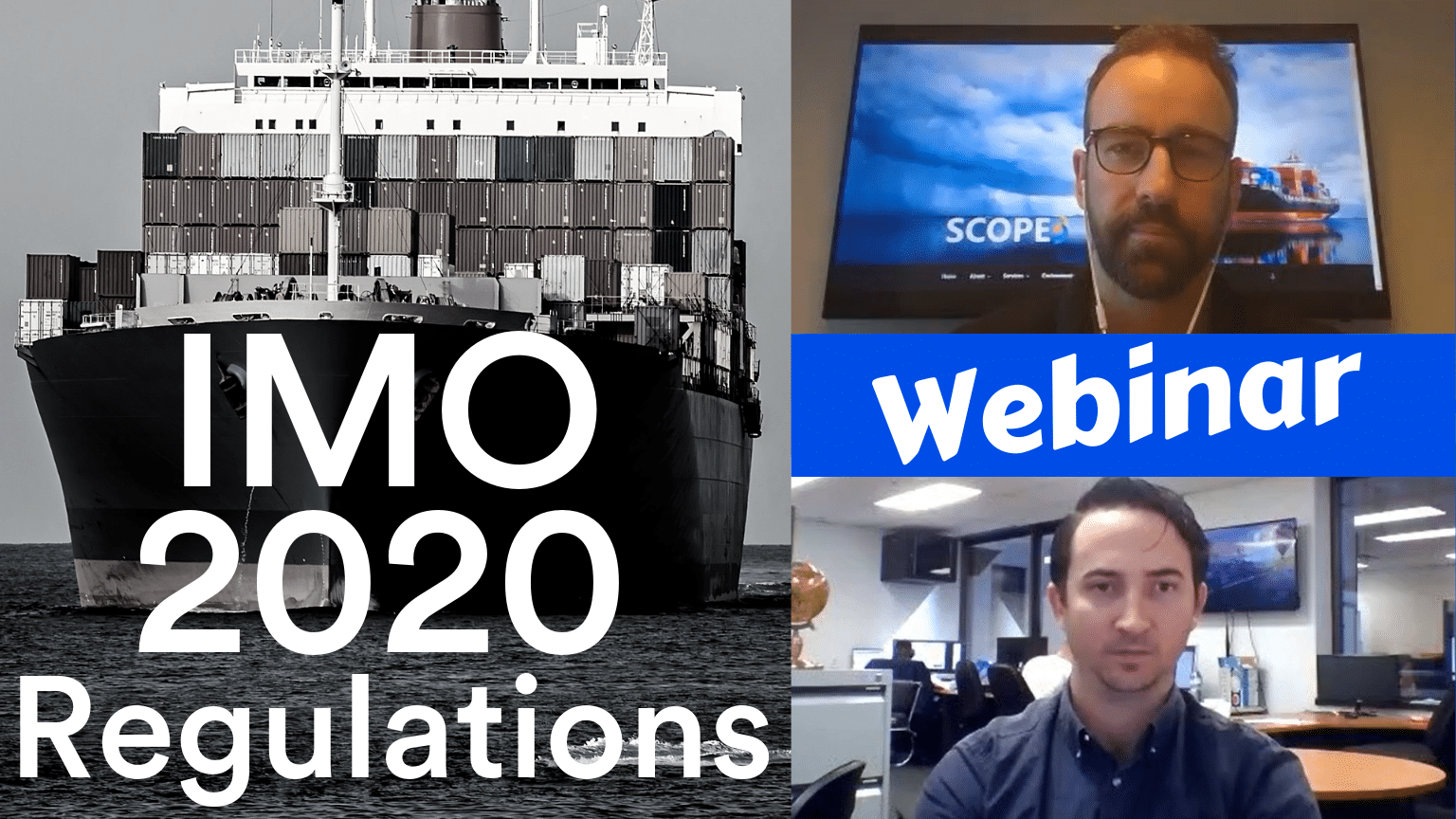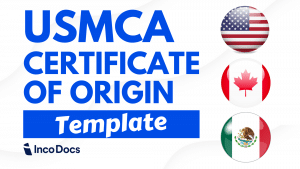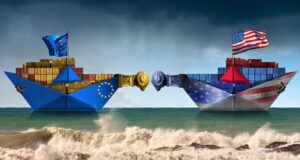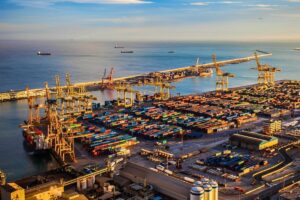The Import Export Podcast
The International Maritime Organization announced new IMO2020 regulations that will come into effect on the 1st of January 2020. Shipping lines around the world are preparing to meet strict new Sulphur Oxide (SOx) emissions.
Michael from Scope 3 discusses how new IMO2020 regulations will affect International shipping. We discuss how what the IMO2020 means, how carriers are preparing for the new Sulphur Oxide (SOx) emissions regulations and how shippers can prepare for increased shipping costs in the first quarter of 2020.
Topics Covered:
- What the IMO2020 regulations mean and why they are being enforced throughout the International shipping industry
- How carriers are preparing to meet the reduced Sulphur Oxide (SOx) emissions
- How IMO2020 will increase shipping costs for seafreight around the world
- What end consumers can do to prepare for increased product costs
- How shippers can prepare for these changes and monitor the freight costs to mitigate risk
- Will carrier transit times increase if the practice of ‘slow steaming’ increases
Listen to Podcast
Watch Webinar
Are you working on innovative solutions for the Supply Chain? Contact us for Media partnership opportunities.
Contact UsRead full interview here:
Ben:
Hi,everybody, it’s Ben Thompson here. Welcome to the Import/Export Podcast. Today we’re talking about new IMO2020 regulations. If you’re involved in shipping then you’ve probably already heard of the IMO2020 regulations that are due to come into effect in the industry on the 1st of January in 2020.
Today we’re joined by Michael Blake from Scope 3. Michael is a specialist in the field of logistics emissions and today we’re going to discuss how IMO2020 will affect shipping rates and the industry as a whole. Michael, welcome to the show.
Michael:
Thanks, Ben. Good to be here.
Ben:
So before we get started Michael, can you tell me a bit about the experience you’ve had in the shipping industry and how that’s led to the work you guys are doing at Scope 3?
Michael:
Sure, sure. Like many of us, I’ve been in the shipping game for many years. And about four or five years ago, we started to look at, I guess, sustainability in shipping.
It was obviously a movement away from fossil fuel use in the range of other energy sectors and across the community. And we started to think about how that translated to, I guess, our backyard being shipping and transport. Largely we found that there wasn’t a lot of sophistication or tools in the market to allow our companies to measure the greenhouse gas footprint from transport, seashipping, air freight. And therefore there still is a real inability to be able to influence and manage those greenhouse gas emissions.
So the Scope 3 business was really formed to help companies get some transparency to this part of the business and understand some of the shifts in the agenda around in transport and shipping that started to focus into sustainability.
Ben:
Yeah. Well then with the IMO2020, I guess it’s becoming more of a hot topic and more of an important thing that businesses need to evaluate along their supply chains.
Michael:
Absolutely, yeah. And of course it is new so this is one of the challenges. Being able to I guess, translate what is the changing agenda within the IMO and different industry bodies and translate that through the shippers who are facing just the day-to-day challenges of moving their products around the place and just trying to give them some insights as to why things are changing.
Ben:
Yeah, absolutely. So I guess there’s plenty going on behind the scenes as we lead up to the 1st of January. So to get started can you explain what the IMO2020 regulations relate to, and why they’re actually being enforced in the industry?
Michael:
Sure, sure. So IMO2020, the target was set back in 2016 and it relates to the sulfur content in fuel. So up until 2019 the current allowable tolerance is 3.5% sulfur in fuel. As of the 1st of January 2020, that sulfur content needs to be 0.5%. And so far, the fuel has been on a downward trajectory over a number of years but this is probably the most significant shift in recent terms, times I should say.
It’s basically around cleaning up the amount of sulfur within the fuel, bringing it more in line, I mean domestic trucking and landside fuel compliances had a much lower sulfur tolerance. And obviously the sulfur in fuel is what causes acid rain so it’s not a good thing to be breathing in and that’s why I guess we’ve seen emissions control areas.
There’s been some early adoption emissions control areas in other parts of the world that have actually reduced the amount of sulfur around coastal areas for a number of years. So, in Europe, they’ve been in place for awhile and in the US, so this is really just bringing it to a global level that we all need to be moving in the right direction.
Ben:
Absolutely. So, when it comes to the carrier’s options in reducing those sulfur oxide emissions, what actual options do they have to do that?
Michael:
To put it simply, there are probably two main options. The first one being change the fuel type that they’re using. The heavy fuel oil with amenities is quite crude and certainly low cost, so the alternative to that is to move to fuels that have been more refined and have less sulfur content.
There are also alternative fuels like LNG which are more strategic, I guess deployments by the carriers, there are a large number of vessels in operation and they need to be looking for alternative fuels. So, LNG plays a role in the future and certainly biodiesel and other products. So, fuel is one way to go about it. The other way is to fit what are called scrubbers to the vessels. And, I guess, there are two main variants to those. There’s an open loop and a closed loop scrubber.
Just to drill into that a bit more, the open loop scrubber goes through a process of removing the sulfur from the exhaust fumes, but then has the ability to, I guess release that water into the oceans. A closed loop scrubber keeps all that sulfur water, if you like, on board the vessel to be discharged in a sort of a more managed way. I guess the two main differences there you’ve got an operational expense if the carriers are going down the change in the fuel type.Whereas, the scrubbers are more of a CapEx expenditure, sort of in the realm of depend on who you ask if the 5 million dollars to fit or retrofitted scrubber to an existing vessel, possibly less if it’s a new vessel. And this is where the carriers are grappling and hedging around where they’ll make their investment to be compliant.
Ben:
And where do you see them actually making the most change? Is the change lending towards changing fuel types or installing scrubbers, or a mix of both? What’s going on in the industry right now to prepare?
Michael:
I think largely it’s going to be more on the fuel side. I think to be blunt, the industry has left that’s run a little late and the ability to fit scrubbers is at capacity. So there’s only a certain amount of scrubbers that are able to be fit within the time frame. And I’m not exactly sure on what that number is, but that is at capacity, anything outside, any carriers that haven’t already locked in getting scrubbers in place some time ago will be in the market buying fuel. So it’s largely going to be a fuel, but certainly, there are scrubbers in the market.
Ben:
Okay. So, we’ve got the shipping lines that have to make these changes to meet the regulations, which is to reduce emissions. But I guess, people are going to be wondering how is this actually going to affect the shipping rates. Shipping rates tend to go up and down over the years and there seem to be a lot of different surcharges involved in the industry already. But, how is the fuel prices or the actual sea freight rates going to be affected by these changes?
Michael:
That’s the million-dollar question. I think that the logistics industry and forwarding and shipping, there has been a few questions around certain surcharges in the past and I think that makes it a challenge for both the shippers and the logistics industry to deliver these costs and increases. But, what we’re seeing is that, there will be an increase in cost. The quantum of which, I think a lot of people aren’t really clear on it, including the shipping lines.
On the fuel side this supply-and-demand with the supplier, the low sulfur fuel still has a fair way to play out in how that’s going to impact pricing. So, I think the first 12 months we’ll be learning a lot. And I think the key the way that we’re seeing is that the carriers are approaching this is trying to give shippers transparency to, I guess, fluctuations or movement in the bunker price by extracting out if they’re all in rates that you’re typically buying from that forwarder or a shipping line, is now removing that bunker element to be sitting outside your rate profile and more floating.
Which obviously gives the shipper transparency to particular movement in the bunker because their price will be going up or down. I guess for us the key is that to see from both sides, is that obviously there’ll be an increased cost. These costs are real for the shipping line. So I think that’s an important thing to understand is that it’s not a dodgy surcharge that is just being levied on the shippers.
As always shippers need to keep themselves informed to make sure that they’re in line with changing market conditions, so making sure that as bunker prices are coming off that their bunker prices are going down. So there’s an element to that but, obviously the key here is that the charge is real. Understanding the market, changing market conditions as best they can by staying close to their shipping line providers.
But then also, to ultimately understand that the reason for the increasing cost is to clean up the shipping industry to bring it in line with other transport modes that sulfate in the environment is ultimately not a good thing. So, it’s a good cause at the end of the day.
Ben:
So, I guess shippers they have to be aware that the bunker price could fluctuate alot more than it has done in the past. What are some good tips or resources that shippers can be monitoring to understand in advance, if possible, how the rates are going to go up or down, and by how much? How can they keep an eye on that?
Michael:
Yeah, it’s a great question and I wish we had a silver bullet to that at the minute. But I think the key is to stay connected to the industry and stay connected to your shipping line and logistics providers. I think shipping lines have the best line-of-sight to what’s happening in the fuel markets without hitting off from becoming an expert in fuel markets.
Keeping close to your shipping line partners and understanding what they are seeing in the trends is really important and try and have a really open dialogue about that to, say for them to understand that for pricing purposes, transparency and, I guess a good line-of-sight to where the trends are heading is really important to ensure that we don’t start to induce freight risk in terms of our pricing for import or export product is really important. So, I guess to answer your question it’s really important to keep in close contact with the carriers, keep in contact with the industry bodies that you’re involved with to see where it will beheading.
Ben:
I hope they can provide really open communications and good resources because, like you said, it’s all about communicating that information all the way down the supply chain. Whether it be from the shipping line through a forwarder or whoever they’re dealing with. If they’re not communicating these changes and price arises, I think it’s going to cause some pretty upset people, but if it’s communicated in the right way, maybe people will be a bit more understanding.
Michael:
Correct. As I said before, I think that there will be a sharp learning curve and I think everyone needs to be as prepared as they can for the first quarter of next year. Like anything we expect it will settle down over time, but I think people need to be really tuned to an initial first 12 months that’s for sure.
Ben:
And I guess that these increased costs are essentially going to be passed on to the end consumer. These businesses can only absorb so much cost, maybe, do you think that they will be absorbing these costs or do you think that the cost will, nearly all of that will be passed onto the consumers and will the consumers be understanding about that?
Michael:
Look, it’s a good question. If we go back to the point, that the idea is right that shipping needs to play its role in cleaning itself up around, it’s obviously the sulfur issue but then ultimately greenhouse gas and moving out to 2050 some of this carbon reduction strategies. It all start to be deployed. So, I think it’s certainly for ours it’s a cost that is relevant to be passed on to consumers. We’re seeing buying consumer patterns leaning towards consumers being willing to pay that a little bit more if they know that it comes from a sustainable source supply chain.
So I think, certainly passing on cost to cleanup transport we shouldn’t be too adverse to. But I guess that’s not always straightforward. And our ability to articulate to the consumer these very industry-specific changes is probably quite difficult. So, I think it’s a challenge but, ultimately this agenda around the shifting focus within the IMO around sustainability is not going to be an isolated change. The IMO2020 we will expect that there will be more discussions around these sorts of initiatives in years to come. So I think it’s important that shippers understand that this is a changing landscape and we’re open to learning about it and obviously seeing how that fits in within their business, their brand and those sorts of things.
Ben:
I guess it comes to how they communicate and market that to their clients and their consumers to get that message across that it’s not just an increase in price, it’s communicated as to why that’s actually happening.
Michael:
Correct. Exactly.
Ben:
Yeah okay. So when it comes to the shipping invoices, if it’s going to be a fluctuation in the bunker charges, is that the only thing that shippers need to keep an eye on when it comes to invoices? Will it be re-worded? What will that look like?
Michael:
I think the challenge is that each of the shipping lines will have their own approach to it. Whilst the fundamentals might be similar, the terminology around what they’re going to tag the specific surcharges might be all different, the acronyms will be different. That is the challenge.
Ben:
More acronyms?
Michael:
More acronyms, exactly, that’s exactly what we need in global trade. So, that will be a challenge for shippers to actually differentiate across their six different carriers which charge relates to bunker. But, I think quickly they should be able to figure that out. But what we’re seeing probably is a shift towards an isolated line item. So we should be able to see whether it be a low-sulfur surcharge is probably two ways that it can be employed on an invoice.
It’ll either be a low-sulfur surcharge, which is a specific I guess, low-sulfur cost. Or it will be a more of a floating bunker element which is obviously a direct link to the full fuel price which is being required to meet the IMO compliance. So, that will be the two things of how they’re going to land on anyone’s desk and depending on how the rates are structured with the shippers at the minute, if it’s northbound commodity trader that typically all in rolled-up rates.
So that will be a potential shift away from those historically rolled-in rates, to base + bunker, which is going back in time a bit. So we could see some changes in the way that happen to the market. So shippers should just probably be aware of these potential things coming and I guess work to identify across the different carriers, how the different costs are being applied.
Ben:
And just lastly, carriers will obviously be looking to become as efficient as possible because fuel is now more volatile. Do you think that the practice of slow steaming will become widespread? Do you think transit times could be increased a little because of this?
Michael:
I think the slow steaming element has a fair bit to play out. I don’t see that happening immediately. I think in some of the recent information we’ve seen out of the IMO is it might play a role but I think there are implications to particularly areas like Australia, around what that actually means. I guess, if you start to slow steam to then keep the same levels of service, you have to introduce additional vessels which completely offset the intention around the slow steam in the first place.
So I think there’s a fair bit to play at that yet, vessels have been I guess working on optimizing speeds around fuel use anyway so I think I don’t see that happening in the short term because of some of those complexities. So there’s something that we’ll have to keep an eye on.
Ben:
Yeah, absolutely. Okay, that’s great. Well I think you’ve given a great overview on what it is and what’s happening. I guess only time will tell exactly how the industry manages that. As you said, I think the key is that is communicating these extra charges, that they’re coming and they’re going to be volatile, and if they’re not explained properly to people along the supply chain, it’s not going to be taken up very well. So hopefully we see some really good communications around that to just try and keep people happy.
Michael:
Correct. Yeah, absolutely.
Ben:
Okay, great. Thanks, Michael. I really appreciate your time, you’ve given great insight and we’ll chat you soon.
Michael:
Thanks, Ben. I appreciate it.







